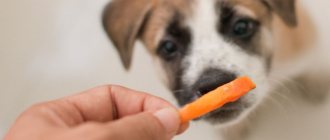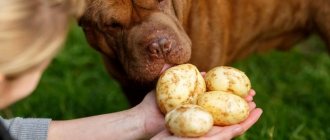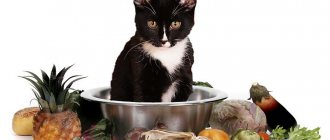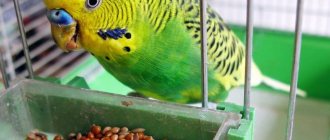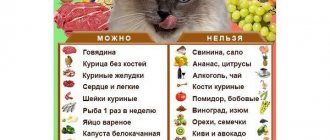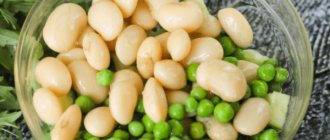For many years now, the dog has been a faithful and devoted friend to man. But the process of domesticating the animal led to the fact that it gradually began to share the lifestyle of its owner in everything. The dog’s diet now includes many foods that are not typical for its body. Her digestive system does not cope well with digesting and assimilating such food. This also applies to nuts. Many dogs perceive them as a treat, love them, and eat them with pleasure. From this article you will learn whether dogs can eat nuts and how to give them correctly.
The dangers of eating nuts
Veterinarians do not categorically prohibit the content of a certain amount of this product in the diet of animals. But they need to be introduced with the utmost caution, given the fact that not all nuts are beneficial for them. In addition, there are species that are prohibited for dogs to eat because they contain toxins and can be dangerous not only to their health, but also to life.
So, what danger can this delicacy be fraught with:
- May serve as an allergen. A dog may develop an allergic reaction after eating one or another type of nut.
- A large fruit can get into the windpipe, blocking the passages and thereby causing suffocation. The kernel usually has an oily surface, which makes it difficult to remove from the respiratory tract.
- If the nut is swallowed along with the shell or part of it, then intestinal obstruction or injury from sharp edges is likely.
- A mold fungus that affects the kernels, if it enters a dog’s body, can cause disruption of the nervous system or gastrointestinal upset.
- The high calorie content of oily kernels can cause the development of obesity or pancreatitis. Given this, they are allowed to be given to animals in very small quantities.
Why are nuts dangerous for dogs?
- An allergic reaction is possible when consuming any of the nuts . When treating your pet, make sure that his skin does not peel off or other signs of allergies appear.
- Quite often, nuts are used during training as a treat. The nut is tossed and caught on the fly by the animal. This is where the unexpected happens - the dog can suffocate. Veterinarians have documented such a tragedy more than once.
- The animal can independently find the nut and crack it. It may not be chewed and swallowed in this form. It may not gnaw completely. In this form, the shell causes either intestinal obstruction or puncture.
- All tree nuts (almonds, walnuts, Brazil nuts, pistachios, pine nuts, pecans) are susceptible to mold . As already written above, mold is not visible in small quantities. But its action has a negative impact on the body’s nervous system, liver, and heart.
- Nuts are high in calories. 100 g contains from 560 to 850 calories. By using them in your daily diet, the risk of becoming obese is high.
- The threat of developing pacreatitis (inflammation of the pancreas) due to high fat content.
PS As you can see from the article, eating nuts in large quantities causes diarrhea. This is due to the fact that nuts contain a lot of fat and the pancreas cannot withstand the load. Nuts are a heavy product. There are not as many benefits from them as nuts can cause harm. It is better to get vitamins from other sources. Therefore, if you want to pamper your four-legged pet, treat him with pieces of fruit or crackers.
Now watch a fascinating video about how a certain squirrel tries to hide a nut in the fur of his dog friend.
Source: www.osobake.by
Nuts allowed for consumption
Let's figure out what nuts our pets can eat. There is a fairly extensive list of types of nuts that, if consumed in small quantities, will not cause harm to the dog.
Pine nut
Pine nuts are the most beneficial for a dog's body. It is highly digestible and contains many nutrients. These are minerals - calcium, boron, copper, vanadium and vitamins A, B, D, E, as well as nicotinic acid. This combination of minerals and vitamins has a beneficial effect on the condition of the circulatory and endocrine systems. The amount of fruits eaten should be limited, since they are very high in calories and regular consumption of them can cause obesity.
Almond
Almonds are also on the list of allowed foods and are even useful in small quantities. The list of minerals contained in it is as follows: phosphorus, magnesium, calcium, zinc. In addition, vitamins B and E. Including this fruit in a small amount in the diet has a beneficial effect on the condition of the skin and coat, and also strengthens teeth. But the content of a large amount of fat can negatively affect the functioning of the gastrointestinal tract.
Of the products made from almond mass, your dog can be given a little almond milk, but only if there is no allergy. But almond oil is completely prohibited. Your dog should not eat bitter almonds because they contain cyanide, which is a strong poison.
Brazilian nut
It will not cause harm if the dog receives no more than one piece per day. Its high calorie content can cause excess weight and also lead to the development of pancreatitis.
Cashew
Cashews are beneficial because they contain large amounts of magnesium and calcium. This fruit has less fat content and is easier to digest. Cashews can be fed daily, but in small quantities, otherwise diarrhea may develop.
Peanut
Peanuts can be called a healthy product, naturally, provided they are fed within reasonable limits. It belongs to the legume family, and this explains its lower fat content. It contains a large range of nutrients: a large amount of vegetable protein; potassium, sodium, phosphorus, iron, zinc; vitamins of group B, A, E, K; folic acid and amino acids. Eating peanuts has a good effect on the cardiovascular, nervous, endocrine systems, and liver (it is a choleretic product).
Peanuts also have a number of negative qualities, so they should be given with caution. In some cases it may cause allergies. This is a difficult product to digest. It can cause bloating and increased gas production. It should never be given to dogs with kidney or liver failure.
Pumpkin and sunflower seeds
Pumpkin and sunflower seeds can be given to your dog. Pumpkin seeds contain a large amount of microelements. In addition, their use is a good prevention of helminthiasis. It is recommended to give them peeled.
In any case, you should give nuts to your pet, observing a number of precautions. The basic rules are:
- It is better to give the kernels crushed. This will eliminate the risk that the animal will choke or a large fruit getting into the respiratory tract will cause suffocation.
- Treats should be given in small quantities and not daily, but periodically, as a reward.
- You should not give nuts to animals with allergies, or with abnormalities in the pancreas, stomach and intestines.
- Attention should be paid to proper storage of fruits. The appearance of mold makes the nut unsuitable for dogs to eat. Fried, sweet or salty kernels should also not be given.
If possible, nuts should be replaced with special dog treats or pieces of fruit. This is more beneficial and safe for the dog’s body.
Read more about the benefits and harms
Cedar
The best choice from all the variety. Pine nuts are relatively safe and highly digestible. These nuts contain calcium, boron, iron, vanadium, iodine and copper - all these substances have a beneficial effect on the circulatory system, coat condition and metabolism.
Important! The only thing the owner should remember is that nuts themselves are very high in calories. So 100 grams of pine nuts contain 620 calla
This means that, even if the use of this product does not cause any particular harm, it is still not worth abusing it.
Dogs should eat them in moderation: one to two nuts per day. If your pet doesn’t get worse, you can try giving it more often.
Coconut
The coconut itself is not particularly healthy, but coconut milk is of great value. It consists entirely of saturated fat. Coconut oil heals wounds, has a positive effect on the dog's skin, helps get rid of fleas and makes the coat brighter.
At the same time, coconut oil increases energy and prevents many dog diseases.
It is important to monitor the dosage. Take the ratio of one teaspoon to 10 pounds of pet's weight.
You can feed once a day. If you accidentally overdo the dosage, diarrhea may be a side effect.
Peanut
Peanuts are called nuts, although it is more correct to classify them as legumes. Peanuts contain protein, sodium, magnesium, phosphorus, zinc and vitamins, which have a beneficial effect on the general condition of the animal. This product is safe, but if the dog has allergies, it can harm the pet.
Peanuts are contraindicated in dogs with kidney and gallbladder problems. When fresh, it is poorly digestible, and when fried it is even harmful. What about peanut butter, you can give it, but the daily intake should not exceed one teaspoon.
Cashew
Because Since cashews contain calcium and magnesium, this nut strengthens the dog’s bones well and often acts as a supplement. Compared to peanuts and pine nuts, cashews can be consumed more often and in larger quantities.
However, they should not be abused. Despite the fact that cashews are not as high in calories as other nuts, consuming them excessively in your pet's food can lead to vomiting, diarrhea and allergies.
Almond
Almonds are less toxic, but consuming them in large quantities leads to vomiting, diarrhea, and often pancreatitis. Norm: 2-5 nuts per two days
You can give almond milk, but again it is important to monitor the amount
Attention! Almond oil is strictly prohibited.
Pecan
Daily norm: 1-2 nuts, but no more. Otherwise, eating large amounts of pecans will lead to death. Pecans are very high in calories and have a bad effect on the dog’s body as a whole.
Brazilian
No more than one piece per day is allowed, otherwise you will have to deal with diarrhea and vomiting one way or another. Brazil nuts contain a lot of calories and often lead to gastrointestinal problems.
Strictly prohibited. Because Hazelnuts contain a lot of iron, which leads to the formation of stones in the bladder.
Pistachios
Often covered with mold, which contains neurotoxins that are dangerous to dogs. Pistachios are salted, and salt is known to have a bad effect on the animal’s body.
Walnuts
Walnuts swallowed whole can cause intestinal obstruction. Because It contains a lot of phosphorus, which often leads to the formation of stones in the bladder. Mold causes tremors and seizures.
You may hear that dogs often eat walnuts and shells without any consequences. However, it's not worth the risk. The shell may get stuck in the throat, causing your pet to choke.
Macadamia
Macadamia is native to Australia and is rarely found in Russia. The nut causes severe poisoning, manifested primarily in the form of convulsions, weakness, rapid heartbeat and paralysis of the limbs. For a puppy or old dog, trying to eat such a nut can be fatal.
Important. Even 5-6 macadamia nuts can harm your pet.
Muscat
If a dog eats it, it runs the risk of severe poisoning, which can lead to coma. Nutmeg causes paralysis of the limbs, tremors, and sometimes leads to death.
Acorns
They are dangerous due to their high content of halothannin, which causes poisoning and leads to kidney failure.
Dogs are prohibited from eating not only the acorns themselves, but even oak leaves and bark. The content of the toxic substance in acorns is so high that even a puddle with oak leaves floating in it poses a great danger.
Chestnuts
Horse chestnut should not be consumed. If we talk about the common chestnut, it usually acts as a rare delicacy, but eating it in large quantities by a dog leads to stomach diseases, diarrhea and pancreatitis.
Which nuts are prohibited for consumption?
There is a whole list of types of nuts that are prohibited for dogs. They should not be given to dogs under any circumstances because they contain toxic substances or are very difficult for the body to absorb.
Walnuts
Walnuts are prohibited for dogs, although they contain a large amount of beneficial minerals. Large amounts of phosphorus can cause bladder stones.
When walnut kernels become moldy, the entry of mold particles into the body leads to neurological disorders in the form of seizures and paralysis.
Walnuts pose another danger. A dog can swallow a large fruit whole, causing intestinal obstruction.
Pistachios
Pistachios have several dangerous properties. A high percentage of fat content creates a risk of developing pancreatitis. Ajar valves are often the gateway to infection of the core and penetration of molds containing toxins. A large amount of salt on the shell, when licked by the dog, causes unpleasant consequences in the form of fluid retention in the body.
Hazelnut
Many owners ask whether they can give their pets hazelnuts. It is a source of large amounts of iron. This is not beneficial for animals, as it can cause urolithiasis.
Macadamia
Macadamia is an Australian nut. It is completely unsuitable as food for dogs because it contains toxins that can cause severe poisoning, even death. The main symptoms of macadamia poisoning are tachycardia, unsteady gait, weakness, body tremors, and fever.
Nutmeg
Nutmeg contains toxins that cause neurological manifestations: tremors, convulsions, paralysis and can be complicated by coma.
Acorns
Acorns pose a great danger to dogs. They contain a strong toxin that, if ingested, can cause severe kidney failure. This can cause the death of the animal.
Which individuals are contraindicated for nuts?
There are several categories of dogs in whose diet the content of this product is undesirable:
- An older puppy can be pampered with small quantities of pine nuts, peanuts or cashews. They are better absorbed by the body. It is not recommended to give nuts to very young children.
- Pregnant females should not eat nuts, as the increased burden on the body may make it difficult to digest heavy foods.
- A nursing mother can be given several kernels daily to enhance lactation. It is necessary to choose a safer option for them: cashews, peanuts or pine nuts.
- Nuts are prohibited for individuals who are allergic or have kidney and gastrointestinal diseases.
You can avoid unpleasant reactions from your pet’s body to eating nuts by controlling their quantity, as well as by not allowing prohibited types to be consumed. If this happens and there are symptoms of poisoning, you must immediately contact a veterinary clinic, avoiding self-medication.
